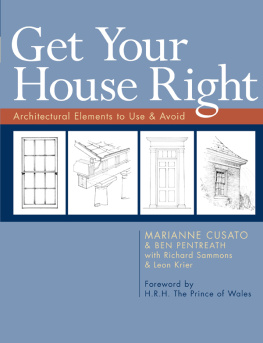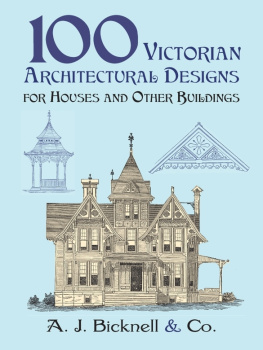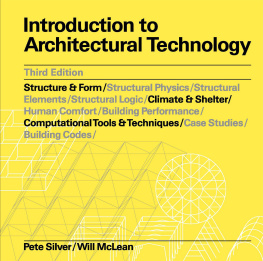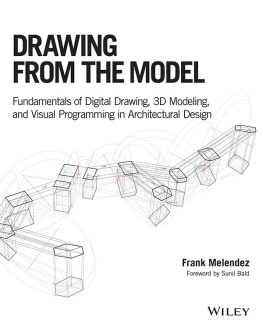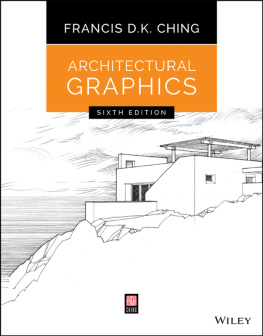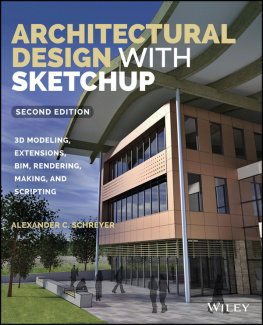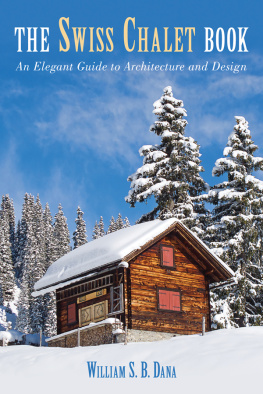

An Imprint of Sterling Publishing
387 Park Avenue South
New York, NY 10016
STERLING and the distinctive Sterling logo are registered trademarks of
Sterling Publishing Co., Inc.
2007 by Marianne Cusato, Ben Pentreath, Richard Sammons, and Leon Krier
All rights reserved. No part of this publication may be reproduced,
stored in a retrieval system, or transmitted, in any form or by any means,
electronic, mechanical, photocopying, recording, or otherwise,
without prior written permission from the publisher.
ISBN 978-1-4027-9103-1 (paperback)
ISBN 978-1-4027-7622-9 (ebook)
For information about custom editions, special sales, and premium and
corporate purchases, please contact Sterling Special Sales at 800-805-5489
or specialsales@sterlingpublishing.com.
2 4 6 8 10 9 7 5 3 1
www.sterlingpublishing.com

ACKNOWLEDGEMENTS
THIS BOOK BEGAN AS A SERIES OF FAXES in 2000 between Andres Duany, Leon Krier, and Marianne Cusato, cataloging many common mistakes found in todays traditional architecture. Over the years that series of drawings grew and evolved through many formats into the book that you are holding today. It has been a lengthy process, but a worthwhile journey, and one only made possible with assistance from many friends and colleagues along the way.
We are grateful to H.R.H. The Prince of Wales for his interest in the book, and to Paul Kefford and Manon Williams in his office.
Thank you to Anne Fairfax, Diane Dorney, Rick Mullin, Jim Taylor, and Seth Weine for their reviews and comments to several of our early drafts; to Julie Trelstad for recognizing our potential, and to Anne Barthel, our editor, for her tireless work in bringing this book to print.
Hank Dittmar, Ben Bolgar, and Saad Ghandour of the Princes Foundation have been supportive, as have Paul Murrain, Russell Versaci, and many other colleagues. Special thanks are due to Paul Gunther, Christine Franck, Henrika Taylor, Steve Semes, and Briana Miller of the Institute of Classical Architecture and Classical America.
We would like to thank our many mentors who have guided our education and inspired our love of architectureMilton Grenfell, Charles Morris, Thomas Gordon Smith, Duncan Stroik, Richard Economakis, Victor Deupi, Norman Crowe, Cara Caroccia, and Michael Lykoudis.
Irina Woelfle and Deborah Slaunwhite were of special importance in the final stages of this book. Irinas counsel and friendship have been invaluable. Deborahs calm and dependable personality have kept Marianne in business while finishing the book. Thank you also to Mark and Cristi Pledger for their friendship throughout the entire process.
Finally, we owe a very special thank-you to Andres Duany. From the days of the first faxes to today, Andress guidance and support has been instrumental in the development of this book and in our work.

In a world of ever-increasing homogenization and standardization, where ever more pettifogging rules and regulations suck out the character, charm and spiritual meaning from every pore of our human experience, the need to champion a living tradition of building and cultural continuity could not be more vital. As such, this splendid book has appeared at a very timely moment.
At long last, we are witnessing an increasingly widespread appreciation of the value of building in traditional ways. Across the world architects, town planners and builders are looking once again to time-honoured classical and vernacular sources as their inspiration for building today.
Sadly, it is all too apparent that despite our best intentions the traditional buildings that are being constructed today do not always feel 'right'. Why is this? So often, they seem to fail in the small details - the proportion of a window, or a badly-detailed door surround, or in a mistaken or short-sighted choice of materials.
As Leon Krier writes so eloquently in his introduction to this book, the problems stem from an appalling interruption in the teaching of basic traditional skills. During the last century, architects and builders lost much of the innate knowledge - both theoretical and practical - that had been built up by their forefathers for generations. It is a hard task indeed for us to re-educate ourselves, and to learn again the way in which our ancestors managed to build so beautifully, yet economically, and in sympathy with their local surroundings. This wonderful book should, I hope, make the task very much easier.
The project was the inspiration of a young American architect, Marianne Cusato, who wanted to explain in simple language exactly what the builder needs to know and her beautiful drawings form the core of this book. Her energy in promoting good traditional design in the United States, most recently with the marvellous Katrina Cottage, seems to know no bounds! I am delighted that three people who are well known to me have joined her in this task: Leon Krier, of course, needs no introduction, but it is no surprise to me that the master-planner of my own development at Poundbury, in Dorset, should be as skilled at understanding the small details as much as the bigger picture! Richard Sammons, an alumnus of my Foundation's first Summer School, and one of many wonderful classical architects practising in America today, has a particular expertize in the theories of proportion and historical construction; and Ben Pentreath, also an alumnus, has worked for my Foundation for the Built Environment in London. I am enormously proud that someone so adept and skillful, and with a real gift for design and draughtsmanship, should be working alongside my Foundation, and also at my development at Poundbury, to help stem the tide of brutality and ugliness which has been the hallmark of the 20th century.
I should like to congratulate all these remarkably sympathetic practitioners for producing such a complete - yet concise - book, from which I confess I have already learned a great deal! It should prove invaluable not only to builders and students, but - I suspect - to many architects. As the traditional architectural movement continues to grow around the world, and particularly in America, it is heartening to see a renewed appreciation for the finer details of old buildings and natural materials. It is my heartfelt hope that this book will help to re-establish a thriving - and genuinely authentic - practice of traditional design and building in our own time.


AMERICANS VISIT FALLING WATER in religious awe, but when they choose a home, they turn for inspiration to Williamsburg and Mount Vernon, to the vernacular and classical models. Despite sustained efforts to re-educate the public according to modernist ideals, traditional designs have never ceased to dominate residential architecture in the United States. And yet even though houses of the futureno longer look futuristic, the modernist propaganda has done lasting damage. The scandalous truth is that the vast majority of architecture schools today simply do not teach the theory and practice of traditional house design. Worse, they have erased the subject from their technical, intellectual, and artistic horizon.
Next page
